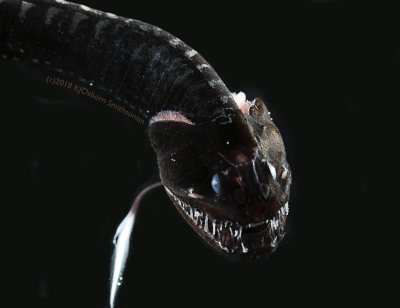The skin of fish that live deep beneath the surface of the sea represent some of the blackest materials known on Earth, absorbing more than 99.5 percent of light that hits its body. The discovery could pave the way for artificial replicas of the skin, which could be used to produce items where the blacker the material, the more effective, such as telescopes and camouflage.
Researchers led by Karen Osborn, from the Smithsonian's National Museum of Natural History, and Duke University's Sönke Johnsen, started investigating deep sea fish skin when they noticed how difficult it was to photograph them during a research expedition.
"They either had to overexpose the image because the animals were so black, or all you could see was a silhouette," Alexander Davis, a doctoral student in biology at Duke University, told Newsweek. "After that, they began thinking about how black these fish may be and what that black was used for. Given how much bioluminescence there is in the deep-sea, we thought these fishes may be using ultra-black as camouflage."
Davis is a co-author on a study that has been published in the journal Current Biology on the properties of the ultra-black fish skin. The team looked at 16 species of distantly related fish that live in the deep sea. Findings showed that all of the species have a continuous layer of melanosomes, which is involved in light absorption, that allows them to reflect almost all light that hits them.


Around 650 feet beneath the surface of the ocean, light can no longer penetrate. To cope with the darkness, many creatures use bioluminescence, where they create their own light to attract prey or mates. Creatures like the deep sea fish studied would benefit from having ultra-black skin as even if they are approached by a bioluminescent predator, they would not be seen. "If you want to blend in with the infinite blackness of your surroundings, sucking up every photon that hits you is a great way to go," Osborn said in a statement.
By analyzing the fish skin for its properties, researchers say it would be possible to artificially recreate this ultra-black material. "Effectively what they've done is make a super-efficient, super-thin light trap," Osborn said. "Light doesn't bounce back; light doesn't go through. It just goes into this layer, and it's gone."
Davis said she believes the biggest implications of the findings will be the potential to create an ultra-black substance that works well in water "using only a random arrangement of small particles."
Artificial ultra-black materials—which are currently based on properties found in birds and butterflies—are currently very delicate and expensive to make. "Instead of building some kind of structure that traps the light, if you were to make the absorbing pigment the right size and shape, you could achieve the same absorption potentially a lot cheaper and a lot less fragile," Osborn said.
Uncommon Knowledge
Newsweek is committed to challenging conventional wisdom and finding connections in the search for common ground.
Newsweek is committed to challenging conventional wisdom and finding connections in the search for common ground.
About the writer
Hannah Osborne is Nesweek's Science Editor, based in London, UK. Hannah joined Newsweek in 2017 from IBTimes UK. She is ... Read more





